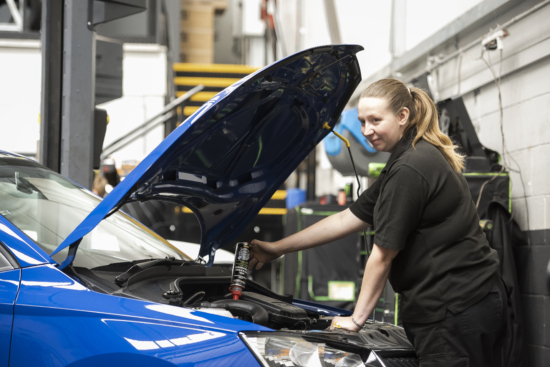Recruitment a clear-and-present-danger to aftermarket profitability
 Halfords executives are calling on government to supports its ambitious recruitment plans (Photo: Halfords)
Halfords executives are calling on government to supports its ambitious recruitment plans (Photo: Halfords)
There has been talk about closing the recruitment gap in the automotive aftermarket for years. More recently certain training bodies and associations such as the NTDA have taking significant steps to renew efforts to recruit and upskill the tyre and aftermarket workforce. Now, however, is clear evidence that these much-discussed issues are not just theoretical. Rather, the lack of skill people in the trade is affecting the ability to service already depleted demand, which is hitting profitability even amongst some of the largest, fastest-growing and most profitable tyre-selling businesses.
Halfords’s recent trading statement is a case in point. Such are their impact on Halfords’s future growth and ongoing profitability, CEO Graham Stapleton, is calling for the government to consider a number of initiatives to help ease the “extremely challenging labour market”:
“Like many businesses, one of the biggest challenges we face is recruitment. Put simply, we can’t get enough qualified technicians into our garages to meet demand. There are parallel issues in many other parts of the economy where large skills gaps are opening up.”
So far, none of this is new. Indeed, all these suggestions were made by the company in November 2022. However, the admission that initial progress of its so-called later life apprenticeship has been slow is a new detail:
“There are many contributory factors, including the well-publicised issue of older people withdrawing from the workforce through the pandemic. We have initiated a Later Life Apprenticeship programme to attract returning retirees, and this is starting to bear fruit, though progress is slow. We are also focusing on attracting more women and young people from disadvantaged backgrounds into automotive apprenticeships.
“There are three practical steps that would help us – and other employers – fill the skills gap: First, the Apprenticeship Levy could be expanded to make it easier to use funds to train existing employees on new technologies. In our case that would mean being able to use the Levy to train colleagues on electric vehicles, advanced driver-assisted systems and autonomous vehicles.
“Second, sectors like automotive have been very narrow in attracting new skills. We need to widen our horizons and reach all communities. Awareness programmes jointly sponsored by industry and government could play a big part in that.
“Third, under the current arrangements when a 16-year-old begins an apprenticeship their parents stand to lose some of their benefits. They can no longer claim Child Benefit, or the equivalent Universal Credit allowance. Other benefits may be affected including housing benefit and/or council tax reduction. The apprentice may be able to claim Universal Credit but the net effect on household income may well be negative and it transfers the benefit from the household to the child. There is, therefore, a disincentive for young people from disadvantaged backgrounds to pursue the apprenticeship path. If apprentices were treated in the same way as young people in education or training it could have a transformative effect.”
Why are apprentices being treated less favourably than university students?
The impact of that last point was also picked up by Hayley Pells, Policy Manager at the Institute of the Motor Industry (IMI), the automotive sector’s professional body, who asked why apprentices are being treated less favourably than university students?
“It’s great to see Government recognising the financial hardships being faced by students. But we fear there is a serious misplaced understanding of the financial position of apprentices. Ignoring this group sends another message that they are the poor relations to full-time students and could deter young people from taking this route in the future. With the skills shortage already critical, this is the last thing any sector needs.
“Of course, apprentices are earning while learning. But the reality is that most apprentices are on either the minimum or living wage – and some may even face redundancy or reduced working hours when economic conditions put pressure on employers.
“Now more than ever we need to make workplace learning attractive and there is much the government could do to support employers of apprentices, especially the small and medium-sized enterprises which make up such a large proportion of the automotive retail sector.
“For example a skills tax credit could be introduced for SMEs, as proposed by the Learning and Work Institute. SMEs could also benefit from a well-publicised service and central portal of information to help them understand how to take on an apprentice.
“The Super Deduction which is planned to end 31 March 2023 could also be continued to prompt much needed investment in capital equipment required to support the transition to the technologies of a greener transport future.”
The recruitment-gap-related problems facing the tyre and wider automotive aftermarket are clear. But the creative solutions being offered from within the trade offer the platform for beginning to address the clear-and-present dangers before it is too late.

 Halfords
Halfords

Comments